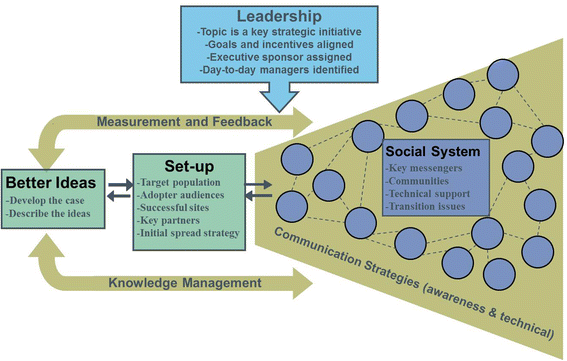A framework for scaling up health interventions: lessons from large-scale improvement initiatives in Africa
- PMID: 26821910
- PMCID: PMC4731989
- DOI: 10.1186/s13012-016-0374-x
A framework for scaling up health interventions: lessons from large-scale improvement initiatives in Africa
Abstract
Background: Scaling up complex health interventions to large populations is not a straightforward task. Without intentional, guided efforts to scale up, it can take many years for a new evidence-based intervention to be broadly implemented. For the past decade, researchers and implementers have developed models of scale-up that move beyond earlier paradigms that assumed ideas and practices would successfully spread through a combination of publication, policy, training, and example. Drawing from the previously reported frameworks for scaling up health interventions and our experience in the USA and abroad, we describe a framework for taking health interventions to full scale, and we use two large-scale improvement initiatives in Africa to illustrate the framework in action. We first identified other scale-up approaches for comparison and analysis of common constructs by searching for systematic reviews of scale-up in health care, reviewing those bibliographies, speaking with experts, and reviewing common research databases (PubMed, Google Scholar) for papers in English from peer-reviewed and "gray" sources that discussed models, frameworks, or theories for scale-up from 2000 to 2014. We then analyzed the results of this external review in the context of the models and frameworks developed over the past 20 years by Associates in Process Improvement (API) and the Institute for Healthcare improvement (IHI). Finally, we reflected on two national-scale improvement initiatives that IHI had undertaken in Ghana and South Africa that were testing grounds for early iterations of the framework presented in this paper.
Results: The framework describes three core components: a sequence of activities that are required to get a program of work to full scale, the mechanisms that are required to facilitate the adoption of interventions, and the underlying factors and support systems required for successful scale-up. The four steps in the sequence include (1) Set-up, which prepares the ground for introduction and testing of the intervention that will be taken to full scale; (2) Develop the Scalable Unit, which is an early testing phase; (3) Test of Scale-up, which then tests the intervention in a variety of settings that are likely to represent different contexts that will be encountered at full scale; and (4) Go to Full Scale, which unfolds rapidly to enable a larger number of sites or divisions to adopt and/or replicate the intervention.
Conclusions: Our framework echoes, amplifies, and systematizes the three dominant themes that occur to varying extents in a number of existing scale-up frameworks. We call out the crucial importance of defining a scalable unit of organization. If a scalable unit can be defined, and successful results achieved by implementing an intervention in this unit without major addition of resources, it is more likely that the intervention can be fully and rapidly scaled. When tying this framework to quality improvement (QI) methods, we describe a range of methodological options that can be applied to each of the four steps in the framework's sequence.
Figures



References
-
- Crossing the quality chasm: a new health system for the 21st century. Committee on Quality of Health Care in America, Institute of Medicine. Washington, DC, USA: National Academies Press; 2001. - PubMed
-
- Nelson EC, Batalden PB, Huber TP, Mohr JJ, Godfrey MM, Headrick LA, et al. Microsystems in health care: part 1. Learning from high performing front line clinical units. Jt Comm J Qual Improv. 2002;28(9):472–93. - PubMed
-
- Hanson K, Ranson MK, Oliveira-Cruz V, Mills A. Expanding access to priority health interventions: a framework for understanding the constraints to scaling-up. Journal of International Development. 2003;15(1):1–14. doi: 10.1002/jid.963. - DOI
Publication types
MeSH terms
LinkOut - more resources
Full Text Sources
Other Literature Sources
Medical
Miscellaneous

